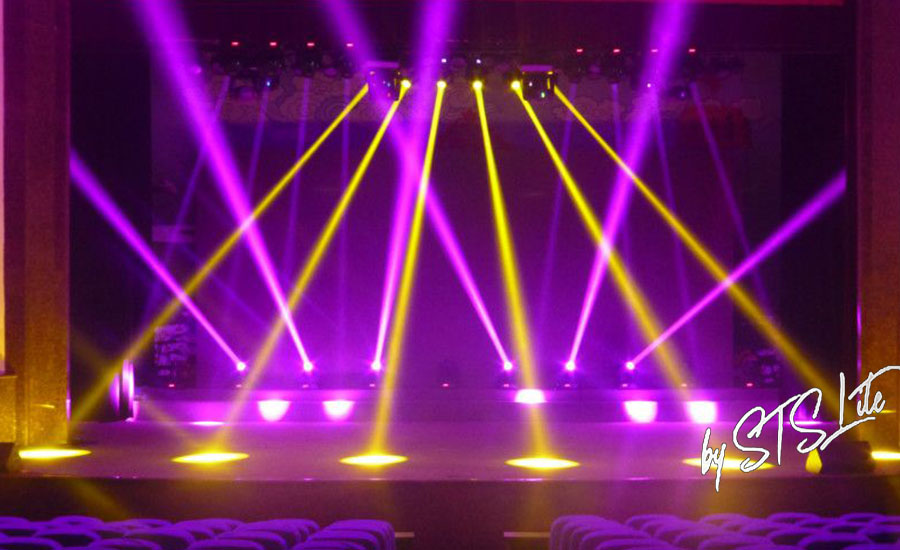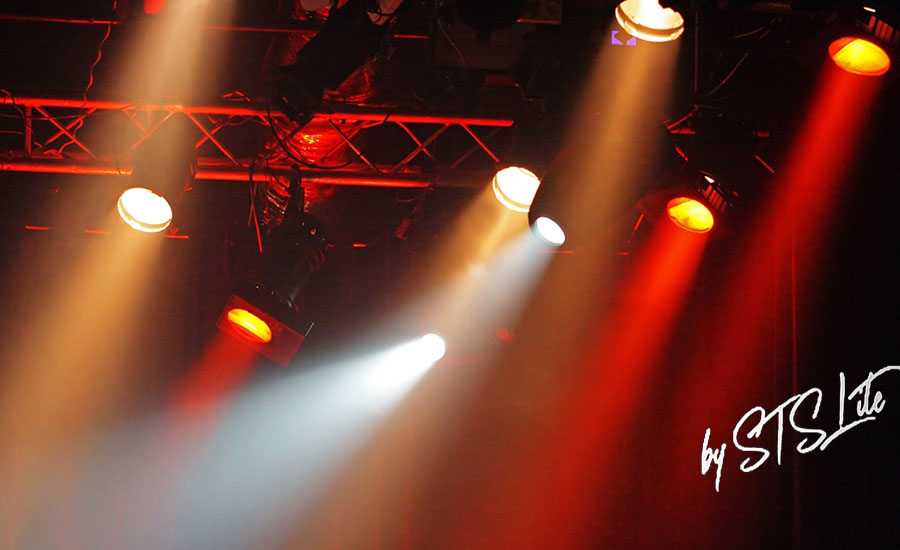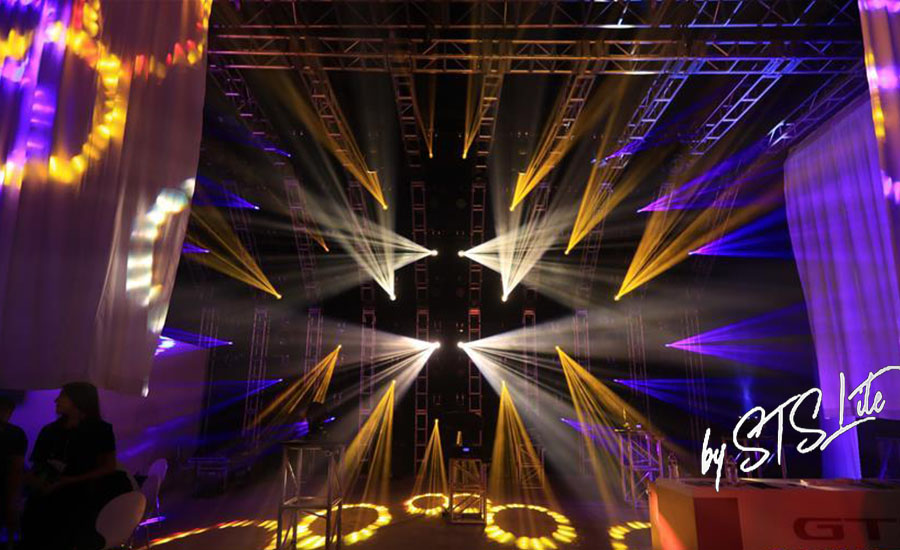Stage lighting is one of stage art modeling. Stage performance lighting is developed with the progress of science and technology. With the development of the plot, stage lighting equipment and technical means are used to display the environment, render the atmosphere, highlight the central characters, create a sense of stage space, shape the external image of stage performance, and provide the necessary lighting effect.

Stage lighting design process
Stage lighting is an important part of the performance space. It is an artistic creation that carries out all-round environmental lighting design for characters and specific scenes according to the development of the plot, and purposefully presents the design intention to the audience in the form of visual image. The lighting designer should show his creativity, imagination, organization and artistic appeal in the lighting design, Moreover, they should have a certain comprehensive artistic quality, and the ability to create by applying the professional technology and artistic rules of stage lighting. They should be able to use lighting and color to shape the image of stage characters, express the stage scene environment, depict the diversified space-time pictures needed for performance, and show the stage lighting transformation effect to the audience one by one with the program of synchronous development with the plot. Performance lighting design according to the script content and plot will express the specific situation of light changes in advance in the performance process, appropriate lighting effect design can strengthen the appeal of stage performance, along with the stage visual space feeling presented to the audience and the development of the plot.
Lighting has become a special language for the interaction between the stage and the audience. Like other means of performance on the stage, it describes and narrates the performance scenes from beginning to end.
1、 The brewing of creative conception
The creation of lighting design should first analyze the script, focusing on the analysis and understanding of the plot content, theme, era background, genre style, characters, scene environment, space-time conversion, conflicts, event relations, and the text and visual materials related to the script as a reference for lighting design. Listen to the director's script analysis and the director's presentation report for each major of the creative group, and understand the director's creative guidance intention and specific requirements for each department of stage performance. And with the director, stage supervision and stage design, lighting, clothing, makeup design and production departments to discuss and determine the stage art modeling techniques. On the basis of the above work, investigate and understand the conditions and conditions of theater and stage equipment. According to the status of theater standing lamps and equipment and the spatial characteristics of the performance place, combined with the performance plot and environment, determine the feasible lighting design scheme. Watch the rehearsal to understand the structural changes of the plot, the stage scheduling of the characters, the performance characteristics of the body movements and lines, determine the time and space conversion of the scene, and the change opportunities of the music and sound effects, record or video the stage scheduling of the rehearsal performance, so as to prepare for the head design of the performance lighting.
2、 Scheme design of stage lighting
The design of stage lighting should first organize the stage picture, design the composition, shape the shape, apply the color, deal with the light and shade and light ratio according to the content provided by the script and the information mastered, so as to complete the preliminary idea of the stage picture space conversion. Secondly, the performance means and effects of performance lighting are determined according to the applicable equipment and equipment. In order to achieve the specific visual effect required by the performance, the preliminary visual effect scheme is used to arrange the corresponding stage lighting. Next, according to the plot, scene, emotion, psychology, form, dialogue, monologue, hallucination, dream, association, voice description and other performance methods involved in the determination of the plot, design appropriate performance methods and lighting application effect. We can focus on color application, image application, projection angle, lamp selection and other aspects, and go deep into each specific scenario of the script.
The stage lighting design drawing is to draw the lamp configuration drawing according to the expected lighting design scheme, and constantly improve the design in the drawing process. The drawing process of stage lighting layout map should be implemented in each changing plot. According to the distribution of stage plane and elevation, the drawing process should be regarded as the process of perfecting lighting design and creation. It includes the type, model, position, direction, angle, color, line combination mode, data of loop connection and the graphic representation of the status of color changer, imager, shutter and other supporting equipment. Stage lighting drawing is mainly completed by hand drawing and special computer software.
The final stage light synthesis scheme should be made according to the performance rehearsal. The plan should be integrated with rhythm, melody, melody, lines, body movements and sound effect changes, and the conjunction point of stage lighting conversion should be specifically implemented in the script plot and page position, so as to prepare for stage lighting synthesis in advance.

3、 The production of stage lighting
(1) Production meeting
Clarify the schedule of performance, installation and dismantling, determine the personnel and person in charge of the lighting production and implementation department, and introduce and explain the lighting design scheme as necessary.
(2) Necessary production and preparation
The production of the planned special effects lighting effect, the production of the image lamp modeling film, the test and maintenance of the existing equipment and cables, etc. should be completed before the installation. The ordering of color light filters, necessities, consumables and other equipment should also be completed before installation.
(3) Stage installation
In the scheduled time, according to the light distribution diagram for configuration, wiring installation. It is required to strictly grasp the position, orientation, spacing and other dimensions of lamps, as well as the positioning of color light filters and the selection and connection of control circuits, so as to ensure the realization of lighting modeling effect.
(4) Stage lighting
Firstly, the height and amplitude of the stage edge curtain are determined according to the position of the stage scene. According to the intention of the lighting design, the light is projected on the preset position, and the aperture range of the lamps and the virtual reality of the imaging are adjusted. In the process of lighting, the relative darkness of the stage should be maintained to ensure the accuracy of lighting position and effect. Usually, the lighting design is used to explain the details before installation.
(5) Light discharge programming
Stage lighting (cue) programming is to unify the stage scene environment and characters in the appropriate light and color picture space, and use the computer dimming device to complete the memory storage of the number and brightness of lamps, so as to make the stage characters, interior, exterior, local, perspective, space The changes of background environment and color are arranged according to the sequence, so that the proposed stage lighting scheme can be implemented accurately.
(6) Stage synthesis
Stage synthesis is carried out when the stage staff and the scene are in place, and each department of the performance cooperates with each other. In the synthesis, the lighting effect is modified and improved. The purpose of stage lighting synthesis is to turn the concept of scheme design into the reality of stage visual presentation. According to the needs of stage picture design, the lighting and modeling of characters, scenes and scenery should be carried out, and the actors should cooperate with music, sound, art, lighting, clothing, props, effects and make-up to create a diversified stage space-time visual picture suitable for the plot, It is the final creative stage before the performance is presented to the audience to form an appropriate stage comprehensive art audio-visual language and the synthesis of stage lighting program.
(7) Stage rehearsal
After stage synthesis, the stage rehearsal should be unified under the principle of collective creation. According to the needs of the scene, lines, actions, rhythm, melody, psychological feelings and other aspects of stage performance time and space, the stage rehearsal should adjust and confirm the stage effect in order to modify the lack of performance lighting and improve the design creativity. If conditions permit, technical rehearsal and stage rehearsal before formal performance can be conducted respectively to confirm the final performance effect before stage lighting is presented to the audience.
(8) Stage performance
Stage performance is to convey the performance content to the audience in the form of stage audio-visual art. It needs good performance operation to turn the conceived effect into the real scene effect. Therefore, all the performers are required to work together and cooperate with each other to present the performance to the audience as perfectly as possible with the best effect.

4、 Management system to ensure performance
(1) We need a well-trained professional team. Training and bringing up professional management talents with artistic quality; The professional operators of dimming control, light tracing, stage organization, scene conversion, etc. on the performance site shall be trained. It is required to understand the purpose of plot and lighting effect conversion according to the actual situation of script and stage, and master the operation and management of performance lighting.
(2) We need a good stage art management system. The lighting engineer is required to complete the professional creation process of the director's conception according to the general score of the script or music and the unified management requirements of the stage supervisor. Complete the routine technical inspection before the performance according to the corresponding time period, enter and maintain the mentality necessary for the performance operation in advance, and actively participate in the process of controlling the stage lighting effect conversion as a participant and creator.
(3) We need to accumulate and summarize the experience of performance creation and management. Arrange and archive the stage light distribution diagram, field light distribution diagram and light program conversion management table, and record the stage performance into audio-visual data, so as to prepare accurate technical data for future transition and performance.
Copyright © 2021 GuangZhou STS Lighting Equipment Co.,Ltd. | All Rights Reserved